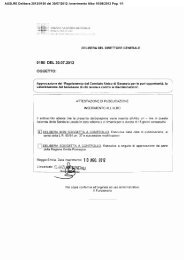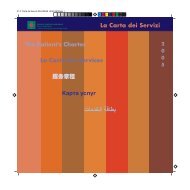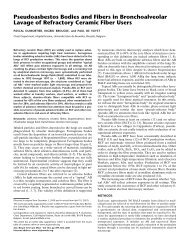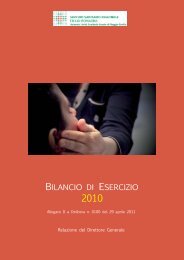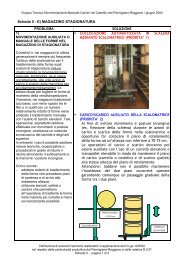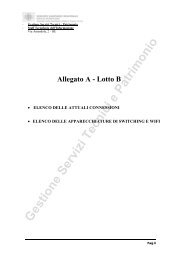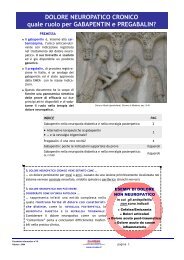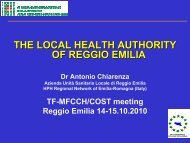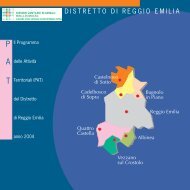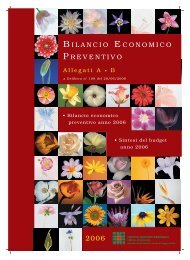Methods for the determination of the hazardous properties - TSAR
Methods for the determination of the hazardous properties - TSAR
Methods for the determination of the hazardous properties - TSAR
You also want an ePaper? Increase the reach of your titles
YUMPU automatically turns print PDFs into web optimized ePapers that Google loves.
3. REPORTING<br />
ECB/TM/26 rev.7<br />
3.1 TEST REPORT<br />
The final report should include but not be limited to:<br />
· The identification <strong>of</strong> test material, ei<strong>the</strong>r by name or code number.<br />
· The composition and o<strong>the</strong>r appropriate characteristics <strong>of</strong> <strong>the</strong> test fibre.<br />
· A description <strong>of</strong> <strong>the</strong> test rats, including strain, source, number, allocation, sex, body weight range, age,<br />
method <strong>of</strong> identification, housing, diet etc.<br />
· A description <strong>of</strong> <strong>the</strong> exposure concentration, exposure regimen, and duration <strong>of</strong> <strong>the</strong> treatment periods.<br />
· A description <strong>of</strong> all methods.<br />
· A description <strong>of</strong> all results.<br />
· All statistical results as described in Section on Data Analysis and Method above.<br />
· Summary tables <strong>of</strong> clearance as described above.<br />
· O<strong>the</strong>r statistical treatment <strong>of</strong> results when appropriate.<br />
· A summary and assessment <strong>of</strong> all adverse effects.<br />
· Figures <strong>of</strong> body weights.<br />
· Summary tables <strong>of</strong> antemortem clinical signs, mortality data, body weights and pulmonary lobes<br />
weights.<br />
· Individual tables <strong>of</strong> body weights, lung burden data, pulmonary lobes weights and necropsy findings.<br />
. Discussion <strong>of</strong> <strong>the</strong> results.<br />
. Interpretation <strong>of</strong> <strong>the</strong> results.<br />
4. REFERENCES<br />
(1) WHO, World Health Organisation, Reference <strong>Methods</strong> For Measuring Airborne Man<br />
Made Mineral Fibres (MMMF), prepared by <strong>the</strong> WHO Regional Office <strong>for</strong> Europe,<br />
Copenhagen (1985).<br />
(2) Bernstein, D.M., Morscheidt, Grimm, H.G., & Teichert, U., "The Evaluation <strong>of</strong> Soluble<br />
Fibres Using <strong>the</strong> Inhalation Biopersistence Model, A Nine Fibre Comparison",<br />
Inhalation Toxicology. 8, 345-385 (1996).<br />
(3) Bernstein, D.M., Morscheidt, C., Tiesler, H., Grimm, H.G., Thevenaz, Ph. & Teichert,<br />
U., "Evaluation <strong>of</strong> <strong>the</strong> Biopersistence <strong>of</strong> Commercial and Experimental Fibres<br />
Following Inhalation", Inhalation Toxicology, 7 (7), 1029-1056 (1995).<br />
(4) Bernstein, D.M., Mast, R., Anderson, R., Hesterberg, T.W., Musselman, R., Kamstrup,<br />
O., and Hadley, J., "An Experimental Approach To The Evaluation Of The<br />
Biopersistence Of Respirable Syn<strong>the</strong>tic Fibres And Minerals.", Environmental Health<br />
Perspectives, 102, Supplement 5, 15-18 (1994).<br />
(5) Neter, J., Wasserman, W. and Kutner, M.H., Applied Linear Statistical Models, Third<br />
Edition, Irwin, Inc., Homewood, Il. (1990).<br />
(6) Stöber, W., McClellan, R.O., and Morrow, P., "Approaches to Modeling Disposition <strong>of</strong><br />
Inhaled Particles and Fibres in <strong>the</strong> Lung." In: Toxicology <strong>of</strong> <strong>the</strong> Lung, 2nd ed., pp.<br />
527-602, Gardner, D.E., Crapo, J.D., McClellan,R.O., eds., Raven Press, Ltd., New<br />
York, (1993).<br />
(7) NF T 03-400 “Determination de la Biopersistence chez le rat – Essai par inhalation”.<br />
- 24 -



